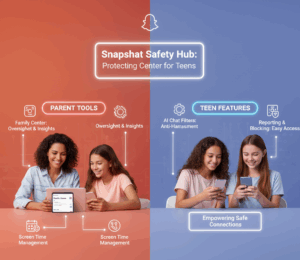An Analysis of the Responses of Platforms to Children’s Online Safety Acts in the Year 2025

An Analysis of the Responses of Platforms to Children’s Online Safety Acts in the Year 2025
The way in which children engage with one another, study, and socialize online has been revolutionized by the emergence of digital media. On the other hand, these advantages come with an increasing number of dangers, which include being exposed to hazardous information, engaging in predatory conduct, and misusing data. In response, governments all around the globe have enacted Children’s Online Safety Acts, which are intended to protect online users who are under the age of 18. These rules will have become a defining factor in dictating how social media platforms function by the year 2025, and the burden is now on technology businesses to demonstrate that they are capable of striking a balance between innovation and responsibility during this time.
Why the Protection of Children Online Became a Priority on a Global Scale
The use of the internet is no longer a supplementary component of childhood; rather, it is an everyday reality. Children spend a significant amount of time online, often without having a clear idea of the long-term ramifications of their digital footprints, using anything from educational applications to social media. In response to a number of causes, legislatures have taken action:
- Concerns about mental health that are associated with continuous exposure to information that is either damaging or addicting.
- Concerns over privacy, particularly in light of the fact that businesses are gathering personal and behavioral data from adolescents.
- In tandem with the rise in popularity of social platforms, there has been an increase in instances of cyberbullying and exploitation.
- An increase in screen time both during and after the epidemic, which magnified the chance of being exposed to online dangers.
- These difficulties have resulted in the generation of new regulations, with governments establishing more stringent criteria for the manner in which platforms manage the protection of underage users.
Children’s Online Safety Acts: Key Characteristics and Features
Despite the fact that the strategy used by each nation is different, the majority of Children’s Online Safety Acts have several things in common:
- Systems for Verifying Users’ Age Platforms are required to guarantee that proper checks are performed to determine whether or not users are underage.
- Stricter Data Protection Rules – Businesses are prohibited from collecting or monetizing the personal information of minors without first obtaining the express approval of the parents.
- The process of screening potentially hazardous or improper information before it reaches young audiences should be given priority via algorithms known as content moderation.
- Parental Controls and Transparency – It is essential that parents have access to tools that allow them to monitor and direct their children’s activities while they are online.
- Protecting Users’ Mental Health Platforms are obligated to lessen the amount of time that underage users are exposed to addictive designs, such as those that include endless scrolling and push notifications.
1. Instagram and Facebook (Meta) are the social media platforms that are responding to the situation.
Through the implementation of age-based experiences, Meta has restricted some services, such as direct messaging, for users who are under the age of 18, and it has also provided parental dashboards for improved supervision. Additionally, artificial intelligence algorithms that have been trained to identify potentially dangerous content directed at adolescents have been used to increase content control.
2. TikTok
TikTok, which has been under scrutiny for a long time due to its impact on younger audiences, has recently implemented screens time limitations by default for users under the age of 18, as well as family partnering features and more stringent controls on tailored advertisements. Additionally, the corporation has expanded its expenditure in educational efforts aimed at promoting youth safety.
3. YouTube
YouTube Kids continues to be the company’s flagship answer to safety concerns; however, recent revisions demand a more stringent verification of age and limit the appearance of potentially hazardous “challenge” videos in the feeds of children. There are less advertisements, and the emphasis is placed on instructional materials.
4. Virtual Reality and Gaming Platforms
For the purpose of preventing grooming, exploitation, and improper connections, businesses such as Roblox and virtual reality social platforms are now introducing real-time monitoring systems, filters driven by artificial intelligence, and enhanced reporting options.
Various Safety Acts That Vary According to Region
United States: The Kids Online Safety Act (KOSA) has compelled businesses to make their safety settings more transparent, to restrict the amount of information that is detrimental to children, and to hold CEOs responsible for any violations that occur.
- The Digital Services Act (DSA) of the European Union (EU) mandates that children must adhere to stringent restrictions around advertising, data usage, and algorithm transparency.
- One of the most stringent standards is the Age-Appropriate Design Code that is implemented in the United Kingdom. This code mandates that all digital services must be designed with the safety of children in mind from the very beginning.
- Countries in the Asia-Pacific region, including as Australia and South Korea, are at the forefront of imposing stringent limits on the gaming and content exposure practices of minors.
Concerns Regarding Compliance That Platforms Are Facing
- Keeping Privacy and Safety in Mind: The process of verifying an individual’s age often involves the collection of sensitive data, which has its own privacy issues.
- Platforms are required to manage a patchwork of rules that vary greatly from area to country. These policies might be either global standards or local laws.
- Moderation of Content on a Large Scale – Due to the rapid evolution of harmful information, it is difficult to filter it without resorting to excessive censorship.
- Problems with Profitability: More stringent ad limitations reduce the number of options for monetization that come from a huge user base.
The Influence on Both Parents and Children
Children will have safer experiences online as a result of these rules, with lower chances of being exposed to dangerous material, being exploited, or having manipulative design shown. Through increasing transparency and control capabilities, parents are able to take a more active role in supervising their children’s usage of digital technology.
On the other hand, there are many who believe that excessive regulation might impede innovation and restrict access to useful information that are available online.
The Future of Protecting Children While They Are Online
A long-term change has been signaled by the adoption of Children’s Online Safety Acts: the protection of kids is no more a feature that may be chosen, but rather a requirement that is both legally and ethically required. What we may anticipate in the future is:
- A set of kid protection solutions that are powered by artificial intelligence and can adjust in real time.
- Enhanced collaboration across international borders in order to establish more consistent safety standards!
- Educative initiatives that assist youngsters realize the dangers of using the internet from a young age.
- In the event that platforms do not comply, there will be increased responsibility for their CEOs and executives.
Children’s Online Safety Acts are redefining how tech companies operate in 2025. Social media giants, video-sharing platforms, and gaming networks are all being forced to adopt safety-first approaches that prioritize the well-being of young users over engagement metrics. While challenges remain, these changes mark an important step toward a digital ecosystem where children can explore, learn, and connect without facing undue risks. The success of these laws will ultimately depend on whether platforms can implement them not just as legal obligations—but as commitments to building a healthier online world for the next generation.






